Subcommittee on Environmental Protection
At the 14th World Winter Cities Conference for Mayors (WWCAM) held in Maardu, Estonia in January 2010, it was resolved to establish a “Subcommittee on Environmental Protection” with the aim of studying environmental issues that are of concern to winter cities.
Based on the Maardu Declaration adopted at the Conference, the Subcommittee hopes to gather information about the kinds of environmental problems member cities are facing so that the data can be shared among them to improve winter city planning.
The Secretariat of the Subcommittee was located in the city of Changchun, China. (Completed in January 2014)
First meeting (July 9, 2010)
Second meeting (July 29, 2011)
Third meeting (January 14, 2012)
Fourth meeting (August 3, 2012)
Fifth meeting (August 1, 2013)
Final report (January 17, 2014)
First Meeting
The first meeting of the Subcommittee on Environmental Protection was held in Ulaanbaatar, Mongolia in conjunction with the 2010 Working-Level Officials Meeting of the WWCAM. Representatives of nine cities from six countries attended the meeting, and case examples of Changchun’s actions were presented.
Outline of the meeting
Ye Chunmin, vice director-general of the Changchun 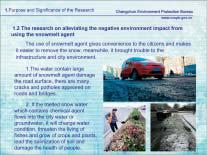 Environment Protection Bureau has announced the research topics for the newly established WWCAM Subcommittee on Environmental Protection, for which Changchun serves as secretariat. Mr. Ye spoke at the WLOM in Ulaanbaatar.
Environment Protection Bureau has announced the research topics for the newly established WWCAM Subcommittee on Environmental Protection, for which Changchun serves as secretariat. Mr. Ye spoke at the WLOM in Ulaanbaatar.
Mr. Ye reported that the Changchun Subcommittee will conduct research on two 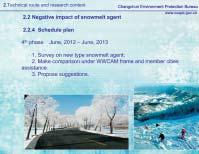 topics during its fouryear term: “An Analysis of Sources of Particulate Matter in the Air in the Winter Season,” and “The Negative Impact of Snowmelt Agents on the Environment.”
topics during its fouryear term: “An Analysis of Sources of Particulate Matter in the Air in the Winter Season,” and “The Negative Impact of Snowmelt Agents on the Environment.”
Mr. Ye spoke about the causes of many environmental problems in the winter season in terms of environmental protection. He pointed out that winter cities should give high priority to promoting citizens’ living conditions, and that good air quality and ecological balance are among the most important factors.
The Changchun Municipal Government has offered to provide support to the WWCAM Subcommittee on Environmental Protection.
Also, two major local research institutes, the Changchun Environment Protection Research Institute and the Jilin Petrochemical Design and Research Institute, have agreed to deliver academic and professional instruction to the Changchun Subcommittee projects.
The Changchun representatives at the WLOM also highlighted the replies to a WWCAM survey of member cities, which provided helpful information for getting the city’s research started. The Changchun delegation indicated it would fulfill its commitment stated in the report to the WWCAM meeting, and that it hoped its research would bring inspiration to the other winter cities.
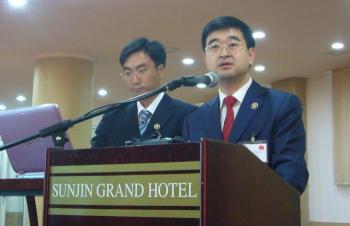
Mr. Ye Chunmin, vice director-general of the Changchun Environmental Protection Bureau, addressed the WLOM.
Presentations
Changchun, China English 1 English 2 English 3
Second Meeting
A meeting of the WWCAM Environmental Protection Subcommittee was held during the Working-Level Officials Meeting, and Changchun, China, the subcommittee secretariat, made presentations on “an analysis of sources of particulate matter in the air in winter season” and on “the mitigation of the negative impact of snow melting agents on the environment”. The following is a summary of the presentation.
・ From the analysis of collected pollution samples, the city has identified characteristics of the substances causing pollution.
・ In the research on the mitigation of the negative impact of snow melting agents on the environment, a survey was conducted on the use of traditional snow melting agents and their environmental impacts. Underground water and soil were monitored in different places and analyzed for the components. The research found changes in the physicochemical property of the soil, damage to plants, underground water pollution, and a decrease in the durability of asphalt.
・ Changchun will continue the project. The city will periodically conduct research on particulate matter in the air, analyze influencing factors, and develop a management/analysis system based on Geographical Information System. For the mitigation of the negative impact of snow melting agents on the environment, the city will monitor the water quality of rivers and underground sources, test snow melting agents, and research and develop new types of environmentally-friendly and cost-effective products.
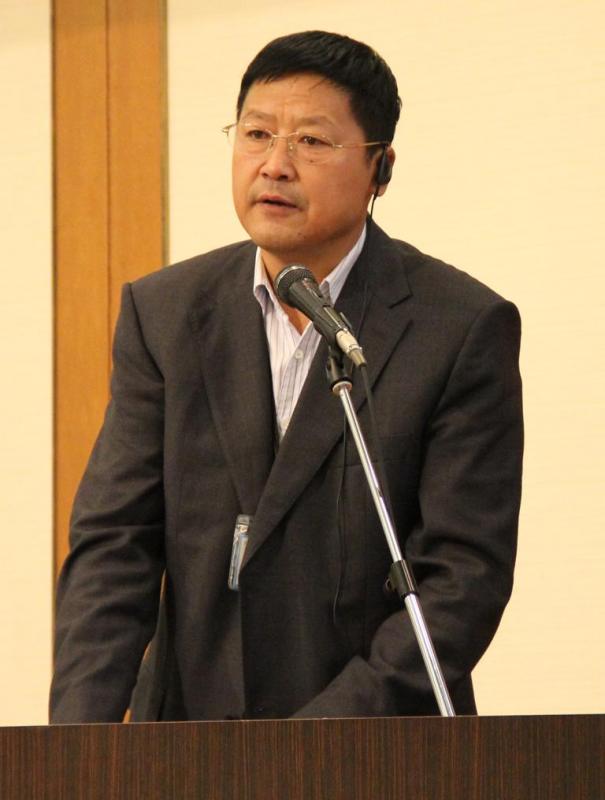
Mr. Yan Wen, director-general, Environmental Protection Bureau, Changchun
Third Meeting
WWCAM Changchun subcommittee was hosted concurrently with the mayor’s conference in Ulaanbaatar on the second day of the event, January 14, 2012. Mr. Yan Wen, director-general of Changchun Environmental Protection Bureau delivered his interim report on the progress made by his team on the two given subjects, namely, the Analysis of source of particulate matters in air in winter season and the Negative impact to the environment by the use of snowmelt agent.
His working team will be able to complete the related research before January of 2014 and all the winter cities will be benefited greatly from the result reached by the study, according to Mr. Yan. The possible solution for air pollution and snowfall are the key environmental issues which challenged the winter cities in the world. Changchun is willing to share its experience and research know-how with all the WWCAM member cities. In reaching his goal, Mr. Yan said the international cooperation under WWCAM frame is very important to the city.
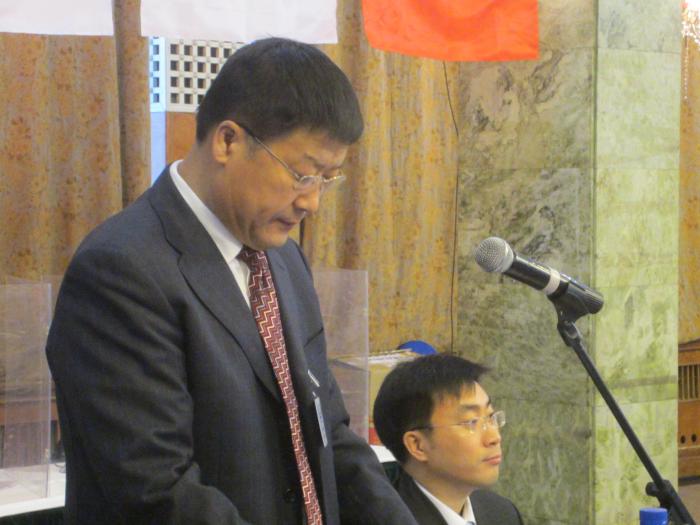
Mr. Yan Wen, director-general, Environmental Protection Bureau, Changchun
Fourth Meeting
WWCAM Changchun subcommittee was held concurrently with the WWCAM Hwacheon Working Level Officials Meeting in Hwacheon, August 3, 2012.
All the winter cities consider this subcommittee as one of the great opportunities for member cities to conduct research and study on a specific subject. And the research will benefit all the WWCAM member cities.
Mr. Wang Xiaodong, vice director-general of Changchun Environmental Protection Bureau delivered his report on the progress made by his team on the two given subjects, namely, the Analysis of source of particulate matters in air in winter season and the Negative impact to the environment by the use of snowmelt agent.
His working team will be able to complete the related research before January of 2014 and all the winter cities will be benefited greatly from the result reached by the study, according to Mr. Wang. The possible solution for air pollution and snowfall are the key environmental issues which challenged the winter cities in the world. Changchun is willing to share its experience and research know-how with all the WWCAM member cities.
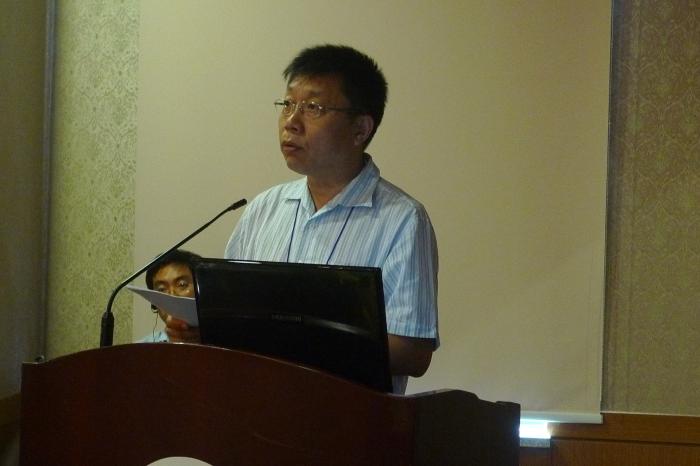
Mr. Wang Xiaodong, vice director-general, Environmental Protection Bureau,Changchun
Fifth Meeting
The WWCAM Environmental Protection Subcommittee meeting was held in conjunction with the WLOM. The secretariat city, Changchun, gave a research report on an analysis of particulate matter(PM) in the air and on the mitigation of environmental damage caused by snow melting agents. The following is a summary of the presentation.
・ As sources of PM 2.5, eight different types of dust samples were collected from wind, the city environment, coal burning, kitchen work, roads, industrial sites, exhaust gas, and construction sites. Ten PM 2.5 monitoring points were set up across the city at an automobile company, a food plant, parks, a telecommunications college, a high-tech industrial zone, the Changchun Economic and Technological Development Zone, and others.
・ PM 2.5 samples were collected in April and May 2013 from an automobile company, a food plant, and parks, and they are currently under analysis.
・ After market research was conducted in collaboration with two local companies, two new environmentally friendly snow melting agents (SMA), non-chloric SMA and calcium magnesium acetate (CMA), were developed with goals of economy and social benefit. The non-chloric SMA uses a by-product of corn processing.
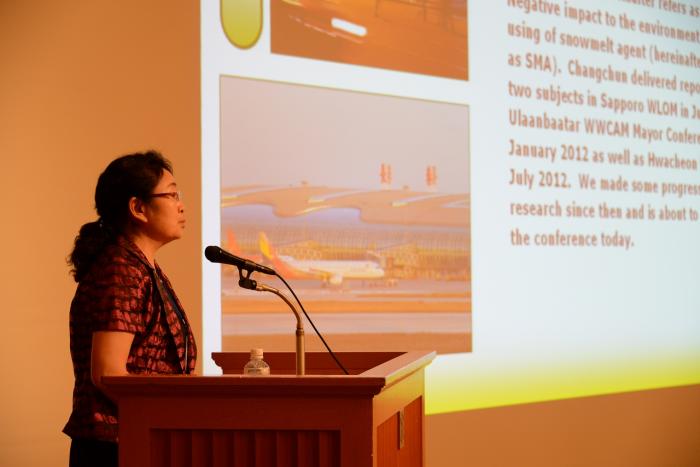
Xiuying Xu, vice inspector of the Changchun Environment Protection Bureau, reports on work of the WWCAM Environmental Protection Subcommittee
Final Report
A final report on the activities of the Environmental Protection Subcommittee was presented at the Mayors Conference by Changchun, China, which has been the subcommittee’s secretariat since the subcommittee was established at the Maardu Conference in 2010.
Changchun has been involved in two projects since the subcommitte was formed: analyses of sources of particulate matter in the air in winter season and an investigation of the negative impact of snowmelting agents on the environment. Changchun has presented five reports since the Working-Level Officials Meeting was held in Ulaanbaatar in July 2010.
1. Analysis of source of particulate matter in the air in winter
Software for PM10 analysis was developed to analyze the atmosphere of Changchun, and features, proportion, and causes of PM10 were identified. The causes of PM10 are different in heating and non-heating seasons. In the heating season wind dust is the top cause of PM10 followed by road dust and industrial coal burning dust. In the non-heating season road dust comes first in the list of causes, and wind dust, industrial coal burning dust, and vehicle exhaust follow. Features of PM2.5 pollution in spring and summer were also identified, which helped prevent and relieve air pollution.
2. The Negative impact of snowmelt agents (SMA) on the environment
The Environmental Protection Subcommittee made a study of the impact of chloric SMA on the environment, including an analysis of its effect on water and soil. Market research on environmentfriendly SMA as well as the environmental, economic, and social benefits from its use was also made.
In cooperation with local businesses, Changchun developed environment-friendly SMAs, such as non-chloric SMA and calcium magnesium acetate (CMA) SMA. The team also conducted tests on the products and planned countermeasures to pollution
caused by SMA and to environmental deterioration by organic SMA. Newly developed non-chlorine SMA is a liquid, and can be sprayed using existing devices. The new product is the same cost as those used now, so the new product is expected to be more economical when expenses for repair caused by corrosion are included.
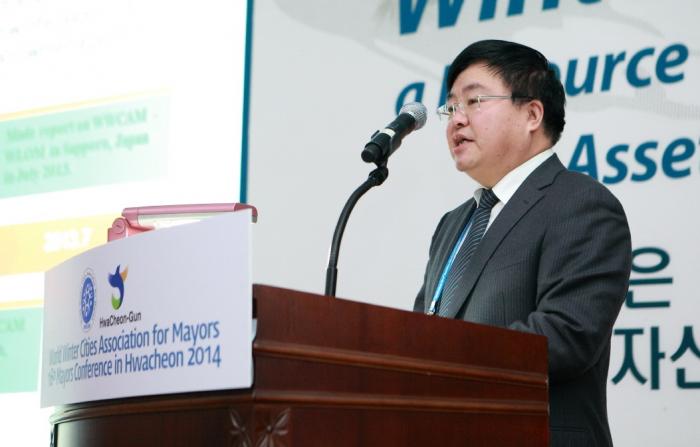
Mr. Ling Zheng kai, vice secretary of the CPC Committee of Changchun Environmental Protection






